Tokyo City Guide: Things to Do, Where to Stay, and How to Get Around
If there is one city you absolutely have to visit once in your lifetime, it’s Tokyo. There, you’ll revel in the dazzling paradox of the neon-soaked, ultra-modern, and sacred tradition.
It’s so much more than a spectacle for tourists, though – visiting Tokyo is a full sensory experience. Rich and varied cuisine, therapeutic bathhouses, and pop culture that is loud in every sense of the word are just a few of the invigorating experiences that await you in the Japanese capital.
To help you along every step of your pre-travel preparations, this Tokyo City Guide is divided into 12 simple categories:
Jump Ahead:
- Tokyo Fun Facts
- When to Visit Tokyo
- How to Get to Tokyo
- Transportation in Tokyo
- Tokyo Neighborhoods: To Visit & to Avoid
- Tips for Safe Travel
- Where to Stay in Tokyo by Budget
- What to Do: Attractions and Activities
- Tokyo’s Local Cuisine and Where to Eat
- Dining Experiences Unique to Tokyo
- Drinking in Tokyo
- Itinerary Ideas for 1 Day, 1 Week, and 2-Week Trips
- Final Tips
Fun Facts About Tokyo
- Tokyo is the most populated city in the world, with a population of 38 million people in the Greater Tokyo Area. That’s greater than the entire population of Canada!
- The emoji that many people think is the Eiffel Tower is actually Tokyo Tower. Modeled after its French look-alike, it’s the second tallest building in the city (next to Tokyo Skytree).
- The three busiest train stations in the world are all in Tokyo. More than 3.5 million commuters pass through Shinjuku Station every day.
- Tokyo has the most Michelin stars of any city. It is home to 13 three-star restaurants, Michelin’s highest designation.
- Tokyo is ranked the safest city in the world by the Economist Intelligence Unit, making it a reassuring destination for travelers.
- Shibuya crossing is the world’s busiest crosswalk. Often as many as 2,500 people cross at a time!
When Is the Best Time to Visit Tokyo?
Well, that depends. Tokyo has plenty to offer all year round, from seasonal landscapes to animated festivals. When planning a trip to Tokyo, take time to consider what’s most important to you. Are you traveling on a budget? Do you want to avoid tourists? Is there a specific event you’d like to attend?
Here’s a breakdown of the best times to visit Tokyo:
For Weather
-
Spring – Cherry blossoms signal the first signs of spring around late March. As the weather warms up, Tokyoites flock to the city’s many parks and gardens for picnics in the open air. By May, the temperature reaches an average of 73°F (23°C), with an average low of 59°F (15°C). Be sure to leave by June, when the rainy season arrives and you’ll find it impossible to go anywhere without your umbrella!
-
Fall – The oppressive summer humidity finally disappears once typhoon season dies down in September. By October, temperatures reach the same range as in May, and the fall colors begin to paint the city. This dry and mild climate is ideal for sightseeing and makes getting around more comfortable, which is important considering how much you’ll need to use public transportation.
For Seasonal Events
-
Cherry Blossom Festivals (March) – Cherry blossom season, or sakura matsuri, is easily Japan’s favorite time of the year. When you see the canopies of pink and white for yourself, you’ll understand why. Tokyo celebrates sakura season with a number of week-long festivals throughout the city. Nakameguro Cherry Blossom Festival, Chiyoda Cherry Blossom Festival, and Sumida Park Cherry Blossom Festival are all great opportunities to admire the flowers and sample Japanese street foods from the yatai (food stalls).
PRO TIP: Cherry blossom season usually arrives in Tokyo during the last week of March, but you can never be too sure. Check festival websites and the cherry blossom forecast to confirm before booking your trip.
-
Kanamara Matsuri (April) – The first Sunday in April is the Kanamara Festival in nearby Kawasaki. Though it is traditionally a festival honoring fertility and happy marriage, today it is better known as the “penis festival.” Centered around a procession of giant phallic statues, the Kanamara Festival is one of Tokyo’s quirkiest celebrations.
-
Tsutsuji Matsuri (April) – Visit Nezu Shrine at the end of the month for the Bunkyo Azalea Festival. The shrine is home to 3,000+ azalea plants, including some rare varieties which are in full bloom this time of year.
-
Sanja Matsuri (May) – Sanja Matsuri is a traditional Shinto festival honoring the founders of Tokyo’s largest temple, Senso-ji. For three days on the third weekend of May, see priests, geishas, musicians, and dancers animate the Asakusa neighborhood. This is a great way to learn about Tokyo’s history and experience Japanese traditions, like taiko drumming, for free.
-
Sumo Grand Tournament (May/September/January) – The Ryogoku Kokugikan (Sumo Hall) opens its doors for 15 days in May for one of three annual Sumo Grand Tournaments. The other Grand Tournaments take place in September and January.
PRO TIP: Those who plan on traveling to Japan to watch sumo wrestling (the country’s national sport) should book tickets in advance, as these are very popular events.
-
Tanabata (July) – High humidity and hot temperatures can make Tokyo summers nearly unbearable. However, the city’s many summer festivals make travel worthwhile. July’s Tanabata (star festival) marks the beginning of the summer festival season with its colorful decorations. Celebrate by writing down your wish and hanging it from a bamboo branch.
-
Obon (July-August) – Later in the month, Tokyo’s first Obon festivals begin taking place. People hang lanterns and perform folk dances at altars and shrines across the city to honor dead ancestors. If you miss the July festivities, don’t worry. A second round of Obon festivals takes place in August.
-
Firework Festivals (July-August) – Summer in Tokyo wouldn’t be complete without hanabi (Japanese firework festivals), the largest of which is the Sumidagawa Fireworks Festival. Over one million people gather in Asakusa on the last Saturday in July to watch 20,000 fireworks illuminate the night sky. It’s an hour-and-a-half-long spectacle unlike any firework show you’ve ever seen.
-
Summer Sonic Music Festival (August) – Summer Sonic is Japan’s largest music festival, taking place in Tokyo and Osaka for one weekend in mid-August. Here you’ll find the biggest names across all genres of the Japanese and international music scenes.
-
Rugby/Baseball/Soccer Season (October) – For sports fans, there’s no better time of year to visit Tokyo than October, when rugby, baseball, and soccer season are in full swing. Catch a rugby or soccer game at Ajinomoto Stadium or a baseball game at the monumental Tokyo Dome.
-
Winter Illuminations (December) – Winter weather in Tokyo is chilly, but the glistening winter illuminations throughout the city make it worth hanging out outside. Each neighborhood puts on its own light show, sometimes accompanied by seasonal attractions like outdoor skating rinks and Christmas markets.
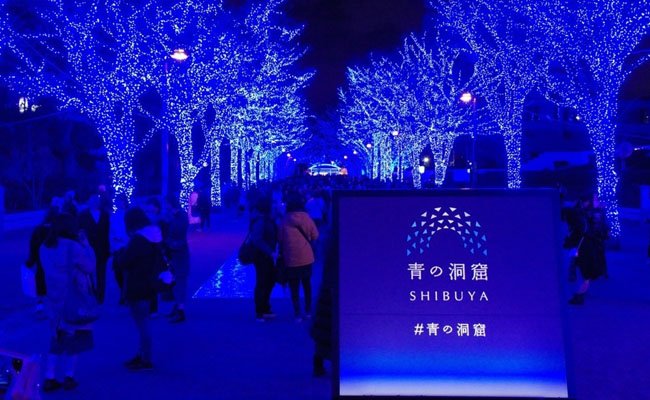
-
New Year’s Eve Celebrations (December 31) – New Year’s Eve is particularly festive in Tokyo, where people flock to the streets at midnight banging pots and pans. The best way to spend this holiday is with locals, eating the bountiful array of dishes in Osechi Ryori (traditional Japanese New Year’s Eve meal).
For Cost Effectiveness
-
Mid-January to March – Late winter is off-season in Tokyo. This is when you’ll find that flight prices and hotel rates drop. However, traveling during this time of the year also means you’ll have to deal with chillier temperatures, shorter days, and fewer festivities.
-
Late May – The first week of May is Golden Week – four days in a row of national holidays – during which many businesses shut down. Many Japanese take this opportunity to go on vacation, which temporarily hikes flight prices to all destinations in Japan, including Tokyo. Just after Golden Week ends, however, flight prices tend to drop.
For Fewer Tourists
-
Fall – One of the most beautiful times to travel to Tokyo, fall is also one of the most peaceful times, as most tourists head back to school and work. October and November may offer fewer festivals, but the nice weather makes up for it.
-
January to February – Naturally, Tokyo is the least crowded during its winter months. Tokyo winters aren’t too cold, though. January temperatures fall to 41°F (5°C) on average, with February temperatures just a few degrees warmer. If you don’t mind missing out on the festival season, this could be the perfect time for you to visit.
Getting to Tokyo
Now that you’ve decided when you’re traveling to Tokyo, it’s time to figure out how to get there. Tokyo has two international airports, Narita and Haneda, each with its own pros and cons. Get to know both of them before booking your flight.
Narita International Airport
Located about 40 miles (64 kilometers) outside of Tokyo in Chiba Prefecture, Narita International Airport is the most popular airport for non-Asian airlines. It is a hub for United and Delta, so you may find prices to and from hub cities in the United States more affordable than from Haneda. Narita is also a hub for Japan Airlines (JAL) and All Nippon Airways Co., Ltd. (known as Zennikkū or ANA) international flights.
For those who prefer to arrive early before a flight, Narita is the best choice. There is an extensive shopping mall, plenty of restaurants to choose from, a cultural center and art gallery, as well as nine premium lounges.
The major downside of flying to and from Narita is its distance from the city. Getting to the airport from central Tokyo can take 1-2 hours and might set you back a hefty sum, depending on your means of transportation.
VERDICT: Choose Narita if you value more international flight options.
Getting to Tokyo from Narita
Although Narita Airport is far from Tokyo proper, transportation to and from the city is actually quite simple. You have four options:
-
JR Narita Express – Also called N’EX, this Japan Rail-operated train connects Narita Airport to Shinjuku, Shibuya, Ikebukuro, Shinagawa, and Tokyo stations in central Tokyo. Prices vary from ¥3,020 ($27.48) to ¥4,730 ($43.03) depending on class and distance. A one-way trip to Shinjuku takes about 85 minutes and costs ¥3,190 ($29.02) for a basic ticket. You can save money by buying a round-trip ticket (valid for two weeks) for a flat rate of ¥4,000 ($36.39). The Narita Express is also covered by the JR Rail Pass.
-
The Keisei Skyliner – Traveling 100 mph (160 kph), the Keisei Skyliner is the fastest way to get to Narita Airport. This is the best option for accessing East Tokyo because it departs from Ueno station. A one-way trip between Ueno and Narita takes about 40 minutes and costs ¥2,200 ($20.02). However, to access west Tokyo, you’ll have to transfer to the Narita Express or to JR metropolitan trains.
-
Bus – Buses are the cheapest way to access Narita International Airport, often costing as little as ¥1,000 ($9.10). This is also the best option for traveling to locations in the Greater Tokyo Area. Check the timetables to find out which bus is best for you.
-
Taxi – Tokyo taxis are expensive. Avoid taking one to or from Narita if possible, at the risk of spending upwards of ¥20,000 ($181.96).
Haneda International Airport
Only eight miles from Tokyo Station, in the heart of the city, is Haneda International Airport. The second busiest airport in all of Asia, Haneda beats Narita in terms of size and traffic – but only when it comes to domestic and intercontinental flights. Non-Asian international airlines are increasingly establishing routes to Haneda, but there are still fewer options than you’ll find at Narita.
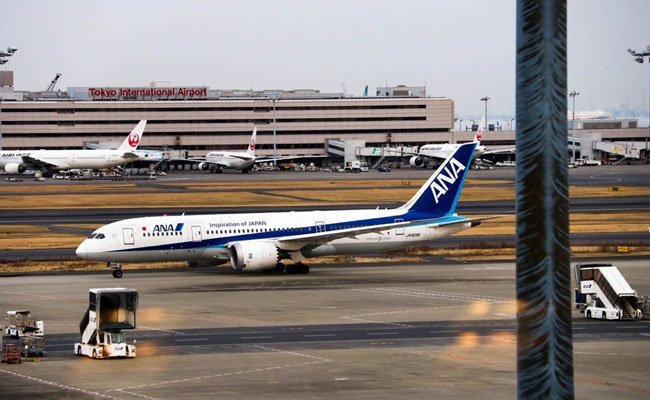
Haneda also offers a wide assortment of restaurants and shops. There are seven premium lounges and one free-access lounge for all passengers.
Compared to Narita, accessing Central Tokyo from Haneda is a breeze. Getting to the city center costs a fraction of what it costs to get there from Narita, but it doesn’t necessarily save you time. Most trips require you to take two trains, which can be a hassle when toting around luggage.
VERDICT: Choose Haneda if you prefer to be close to the city.
Getting to Tokyo from Haneda
The biggest benefit of arriving at Haneda International Airport is that getting to central Tokyo is cheaper and often faster. You have four options:
-
Keikyu Line + JR Yamanote Line – To access central Tokyo, you’ll need to take two trains. It’s a quick, cheap journey that requires transferring and buying two separate tickets. First, take the Keikyu Line from Haneda to Shinagawa Station. It takes 15 minutes and costs ¥410 ($3.73). At Shinagawa Station, transfer to the JR Yamanote Line. The Shinagawa to Shinjuku leg takes 20 minutes and costs ¥200 ($1.82).
Note: The Keikyu Line is not covered by the JR Rail Pass.
-
Tokyo Monorail + JR Yamanote Line – An alternative to the Keikyu Line is the Tokyo Monorail. From Haneda, take the Monorail to Hamamatsucho Station. This leg of the trip takes 15 minutes and costs ¥490 ($4.46). Transfer to the JR Yamanote Line and get to Shinjuku Station in 25 minutes for just ¥200 ($1.82). The entire journey is covered by the JR Rail Pass.
-
Keikyu Limousine Bus – For a direct journey, the Keikyu Limousine Bus connects Haneda with central Tokyo and the Greater Tokyo Area. A trip to Shibuya costs ¥1,030 ($9.37) and takes about 60 minutes. You might sacrifice time and money, but it’s a much easier trip, especially if you have heavy luggage.
-
Taxi– Once again, this is the most expensive option. A taxi ride from Haneda Airport to central Tokyo costs about ¥7,100 ($64.60).
Transportation in and Around Tokyo
Confused by all those trains and station names? It’s only natural. Tokyo is equipped with an incredibly extensive public transportation system that includes trains, subways, and buses. The primary train lines are operated by Japan Rail, while private railways connect Central Tokyo with the Greater Tokyo Area. In addition to the rail system, Tokyo also has two subway networks.
For first-time travelers to Tokyo, the various transportation networks can seem overwhelming and confusing. Here’s what you need to know to navigate Tokyo with ease.
JR Trains
Japan’s public rail company, Japan Rail (JR), operates five lines that run through central Tokyo and parts of the Greater Tokyo Area.
-
Yamanote Line – The circle line that connects most of the major neighborhoods in central Tokyo.
-
Keihin-Tohoku Line – Runs parallel to the Yamanote Line on the eastern side and continues to Yokohama.
-
Chuo-Sobu Line (Local) – Runs through the center of the Yamanote Line.
-
Chuo Line (Rapid) – Also runs through the Yamanote Line, connecting Shinjuku with Tokyo Station.
-
Saikyo Line – Runs parallel to the Yamanote Line on the western side and connects central Tokyo to Odaiba.
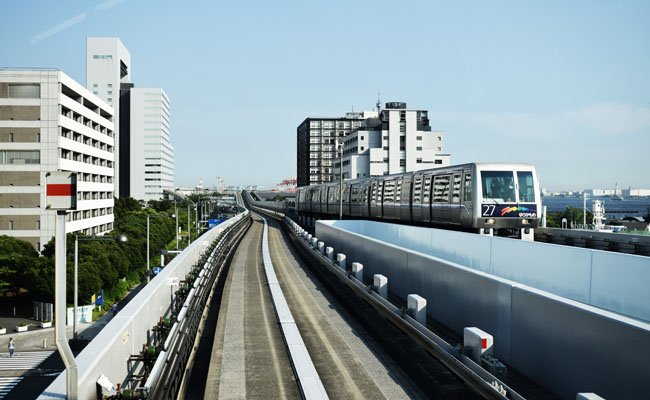
Private Trains
Connecting central Tokyo to outer Tokyo and nearby prefectures, Tokyo’s eight private railways are essential to getting to non-central locations in the metropolis. Most of the private railways connect to stations on the Yamanote Line for convenient access.
- Tokyu Railway – Connects southwest Tokyo to neighboring Kanagawa Prefecture.
- Tobu Railway – Connects north Tokyo to Saitama Prefecture and Tochigi Prefecture. Use this railway to access Nikko, a popular destination for day trips from Tokyo.
- Seibu Railway – Connects northwest Tokyo to the Tokyo Tama (outer Tokyo) region and Saitama Prefecture.
- Keio Railway – Connects west Tokyo to various neighborhoods in the Tokyo Tama region.
- Odakyu Railway – Connects west Tokyo to Kanagawa Prefecture. Use this railway to access Hakone, another popular day trip destination.
- Keisei Railway – Connects east Tokyo to Chiba Prefecture, including Narita International Airport.
- Keikyu Railway – Connects south Tokyo to Kanagawa Prefecture, including Haneda International Airport.
- Tsukuba Express – Connects east Tokyo with Tsukuba in Ibaraki Prefecture.
Subways
There are two subway networks in central Tokyo, with a total of 13 lines. Some subway lines turn into private train lines once they leave the city center, so be aware of your train’s destination before boarding.
- Tokyo Metro – Nine lines that cover the majority of the area within the Yamanote Line circle.
- Toei Subways – Four lines that cover the eastern area of the Yamanote Line near Ginza.
Tokyo Toei Buses
Foreign bus networks can be intimidating, but they are also a great way to get your bearings in a new city. Central Tokyo’s Toei buses cover all the main neighborhoods within and around the Yamanote Line. Toei runs over 1,400 buses per day, which make stops at each of the Toei subway stations from 6AM to 10PM.
Unlike other buses in Japan, Toei buses follow the same system as most western buses. Enter at the front of the bus (the opposite of most Japanese buses) and pay a flat rate of ¥210 ($1.90) for a one-way journey.
Tickets, IC Cards, and the JR Rail Pass
Tickets for trains and subways in Tokyo vary by distance, meaning a one-way ticket might only cost you ¥130 ($1.15), while another might cost you over ¥1,000 ($9). To avoid spending half your travel budget on transportation, consider one of the following options:
-
Get a Prepaid IC Card – IC (Integrated Circuit) cards are practical for hopping between train lines. You can load these rechargeable cards at any train station kiosk to receive contactless access to public transportation. You can also use them for purchases at many konbini (Japanese convenience stores).
The benefit of an IC card is convenience, but the drawback is that you won’t actually save any money. You are credited for the full value of each trip you take.
IC cards relevant to Tokyo include Suica (the IC card for JR trains in the Greater Tokyo, Niigata, and Sendai regions) and Pasmo (the IC card for Tokyo’s railway, subway, and bus system – alternative to the JR Pass).
-
Buy a Day Pass – Unfortunately, because each rail and subway company operates on different tickets, day passes are usually only valid on single networks. Therefore, day passes are a good option if you plan on exploring a single area of Tokyo at a time (read: one network).
The most useful day pass is the Tokunai Pass, which allows access to all JR trains for 24 hours and only costs ¥750 ($6.75).
Tokyo Free Kippu is one day pass which does cover multiple networks, including JR trains, Tokyo Metro, and Toei Subway. This pass costs ¥1,590 ($14.30) per day.
-
The JR Rail Pass – Many travelers to Japan find the JR Rail Pass enticing, as it provides unlimited uses of JR trains to tourists. However, if you plan on staying in Tokyo, a JR Rail Pass won’t actually save you much money. You’ll need to buy additional tickets for every trip on a non-JR train. However, it does cover the Narita Express and is useful if you plan on traveling beyond Tokyo.
Tokyo Water Bus
The Water Bus is a fun and atypical way to explore Tokyo Bay and its islands, such as Odaiba. Three lines offer access to different parts of Tokyo Bay:
-
Asakusa-Odaiba Direct Line – Travel from the cultural center of Asakusa to Odaiba for a relaxing sightseeing cruise through the city. The trip takes about 50 minutes and costs ¥1,560 ($14) one-way. This is a great way to see the Rainbow Bridge!
-
Sumida River Line – This line runs along mainland Tokyo from Asakusa to Hama Rikyu Garden. The trip takes about 25 minutes and costs ¥980 ($8.80)
-
Odaiba Line – Access Odaiba Seaside Park from Hinode in just 25 minutes for ¥410 ($3.70). There, find the popular shopping center Palette Town and the Tokyo Big Sight Convention Center.
Taxis
Tokyo’s taxis are known for being expensive, so budget travelers should avoid using them whenever possible. This may be easy to do during the day, when public transportation is up and running, but once trains stop around midnight, taxis may be the only option for transportation. Typical fares start at ¥410 ($3.70) for one kilometer and increase by ¥90 ($0.80) for every 280 meters traveled.
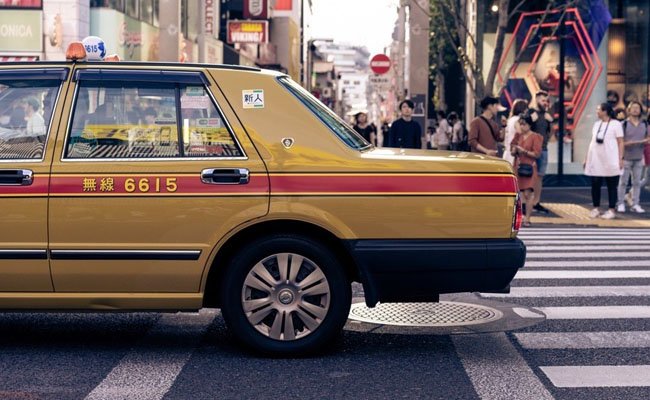
If you find yourself in need of a taxi, you can hail one by using the JapanTaxi app or by going to a taxi stand, which you can find in front of most train stations. A green light signals that a taxi is available and a red light signals that it is not.
Once you’ve found a taxi, there is certain etiquette to follow. First of all, don’t open the door. Taxi doors are operated with a remote control by the driver, who will also close the door for you. Have your destination’s address ready to show the driver so he or she understands where you are going. Most taxis accept cash payment, but some also accept payment by credit card or IC Card.
Renting a Car in Tokyo
If you plan on staying within Tokyo borders, renting a car is probably an unnecessary inconvenience. However, if you’d like to explore the nearby prefectures or visit a lesser-traveled region of Japan, you might consider renting a car.
Popular car rental companies include Orix Rent-a-Car, Toyota Rent-a-Car, and Nippon Rent-a-Car, which are all located on the outskirts of central Tokyo. Prices per day tend to be at least ¥10,000 ($90), not including toll and fuel prices.
PRO TIP: Compare rental car rates using Tabirai.
In order to reserve a car, you must be over 18 and possess a valid non-Japanese driver’s license. For travelers from Sweden, Germany, France, Belgium, Monaco, Slovenia, and Taiwan, this can be a Japanese translation of your driver’s license. For all other travelers, you are required to have an International Driver’s License, which you should purchase at your country’s Department of Motor Vehicles in advance.
Finally, keep in mind that Japanese roads are left-oriented, so you should be comfortable driving on the left side of the road. Make sure to brush up on Japanese driving rules, as all road signs are in kanji (one of three Japanese scripts)!
The Quintessential Guide to Tokyo Neighborhoods
Tokyo is truly massive. The Greater Tokyo Area spans a mind-boggling 5,240 square miles and includes over 1,000 train stations. To make the area more manageable, it’s divided into 23 special wards and 26 surrounding cities. Each of these wards and cities has a distinct personality and so much to explore.
From the areas that can’t be missed to the ones you’re better off avoiding, here’s a breakdown of Tokyo’s neighborhoods.
Tokyo’s Most Popular Neighborhoods
Asakusa – In the heart of Edo-shitamachi (old town Tokyo) sits the city’s oldest and grandest temple, Senso-ji. Walking around these ancient streets gives you an idea of what the city was like hundreds of years ago. Also in the neighborhood is Tokyo’s tallest structure, Tokyo Skytree, where you can view the city from 2,000 feet in the air.
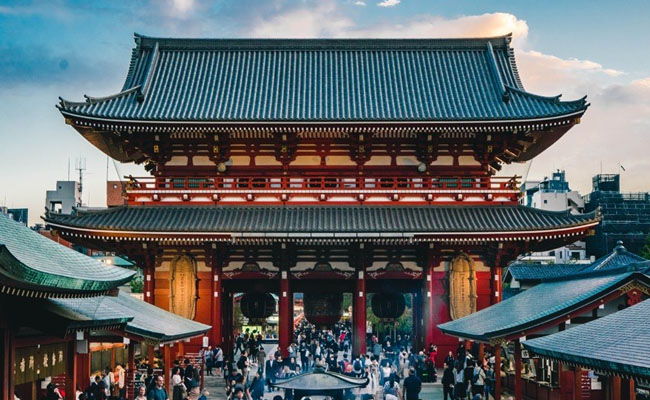
Shinjuku – In the busiest neighborhood of the city you’ll find a little bit of everything. For most of the day (and even throughout the night), office workers in suits shuffle through the streets of departments stores and izakayas (Japanese gastropubs). At night, Shinjuku is a prime neighborhood for bar crawling, karaoke, and even late-night shopping at Don Quijote.
Harajuku – Bright colors, platform shoes, improbable styles, and funky patterns are the norm in Harajuku, where more is more. If you ever wanted to try out a statement look, like goth or Lolita, do it here and no one will bat an eye. Behind the bustling Takeshita-dori shopping street is the Meiji shrine, a peaceful reprieve and one of the most popular shrines in Tokyo.
Akihabara – For all things otaku (Japanese geek culture), come to Akihabara. Here, you’ll find bookstores and libraries of manga and anime alongside electronics stores, arcades, and maid cafes.
Shibuya – After meeting up with friends at Hachiko statue, wander the bubble-gum-colored streets and alleys of Shibuya. Costume stores, themed restaurants, arcades, and an entire building dedicated to photo booths are just a few of the fun establishments you’ll find in the most recognizable district of Tokyo.
Roppongi – Located in the geographical center of the city, Roppongi is home to the esteemed Mori Art Museum, a must-visit for modern art lovers. At night, the neighborhood transforms into a meeting place for nightclub-goers and partiers.
Ginza – Luxury department stores like Ginza Mitsukoshi and Tokyu Plaza Ginza sell the world’s finest brands in this upscale neighborhood. It’s also just a jaunt away from the world-famous Tsukiji Fish Market, where 5 million pounds of fish (worth $28 million USD) are sold fresh every day!
Best Neighborhoods off the Beaten Path
Kichijoji – The neighborhood surrounding the tranquil Inokashira Park is adored for its labyrinthine shopping arcades and the hidden stand-up bars and food stalls of Harmonica Alley. Kichijoji is also where you’ll find the Studio Ghibli Museum, which celebrates the master animators behind classic films like Spirited Away and My Neighbor Totoro.
Chofu – Outside of central Tokyo is the town of Chofu, where temples, shrines, and the Jindai Botanical Garden serve as peaceful breaks from the city. It’s also home to Ajinomoto Stadium, the Tokyo HQ for the 2019 Rugby World Cup.
Shimokitazawa – Cozy cafes, thrift shops, and record stores make up this haven for hip Tokyoites. Though the neighborhood is quite popular now, its low-key location, low-rise buildings, and quiet atmosphere long kept it off the beaten path.
Yanesen – On the eastern side of the city is an area referred to as “Yanesen,” a portmanteau of Yanaka, Nezu, and Sendagi. These three neighborhoods exude all the cool of Shimokitazawa but remain unspoiled by popularity. Edo-era shrines and temples are scattered around, and ancient spaces are transformed into innovative pop-up shops and galleries.
Daikanyama – Sometimes called “the Brooklyn of Tokyo,” Daikanyama is one of the coolest upcoming neighborhoods around. Understated bars and unique shops line its quiet streets. One of the most popular attractions is T-Site, a bookstore broken into fragments and nestled among the trees.
Neighborhoods to Avoid
Kabukicho – Within the confines of Shinjuku is the seedy quarter of Kabukicho. As you walk down the streets of this red light district, you’re bound to be harangued by street hawkers and scammers selling X-rated experiences. Kabukicho isn’t all bad (this is where you’ll find the Robot Restaurant, after all), but you’re probably better off staying away if you’re with your family or partner.
Ueno at Night – By day, cultured locals and tourists frequent the museums and parks of the Ueno neighborhood. At night, the busy shopping street of Ameyoko lights up with carnival-style food vendors and shops. Nearby, though, some of Tokyo’s homeless citizens are known to harass passersby. You might not need to avoid Ueno altogether, but you should be on guard when walking around at night.
Roppongi at Night – The thrill of Roppongi’s raucous nightlife is quickly lost on victims of the area’s rampant scamming. Roppongi-based thieves often target tourists who let down their guard in the area’s nightclubs and bars. Those who go out in this area should watch out for unsavory characters and keep an eye on their drinks, as spiked drinks are a growing problem in Roppongi.
Tips for Staying Safe in Tokyo
-
Leave your credit card at the hotel. Especially if you plan on going out at night. Japan still runs on cash, so once you’ve withdrawn all that you need, safely store your cards at your accommodation. Most scammers target people they see using cards.
-
Get a theft-proof bag. Visitors to Tokyo don’t have to worry too much about pickpockets. Still, whenever you’re in a crowded area, it’s best to keep your belongings close to you, just in case. Invest in a money belt or theft-proof bag to ensure the security of your belongings.
-
Avoid bars advertised by street hawkers. In neighborhoods popular for nightlife like Shinjuku, Shibuya, and Roppongi, street hawkers try to lure passersby for a drink. These are the bars that are most likely to scam you. Seat fees, overpriced drinks, and guilt-trips to get you to buy multiple rounds are just a few of the ways these bars take advantage of tourists.
-
Keep an eye on your drink. Men and women are both targets of drink-spiking. A good way to protect yourself from these criminals is to keep your drink in front of you at all times and keep your hand over the top of your glass.
-
Don’t get too drunk. Assault doesn’t occur very often in Tokyo, but when it does, the victims are often drunk. Visibly drunk tourists are sometimes targeted by thieves and fall victim to physical harassment that may end in theft. Keeping your wits about you is a good rule of thumb.
-
Register your trip with your embassy or consulate. Just in case something happens, like a natural disaster or medical emergency, let your government know where you’ll be traveling ahead of time. For Americans, this means enrolling in the Smart Traveler Enrollment Program (STEP).
-
Get travel medical insurance. Even a mild injury or sickness can put a damper on a trip. To make sure you have coverage if an accident or sudden illness befalls you, purchase travel medical insurance.
Learn what travel medical insurance is or discover why you may need it for your trip to Japan.
-
Call 119 for an ambulance. Easy to remember, but you should jot it down in your contacts anyway.
Where to Get Medical Help in Tokyo
Let’s say some unfortunate medical problem does occur during your trip to Tokyo. Not fun, but definitely not the end of the world. If you have travel medical insurance, you’ll at least know you’re covered for eligible illnesses and injuries.
One thing you can be sure of in Tokyo is that you’re never far from a hospital or medical center. However, finding one with English-speaking doctors is another story.
So that you don’t waste precious time on your trip trying to explain your ailment charades-style, here’s a list of English-speaking medical facilities throughout the city:
St. Luke’s International Hospital
9-1 Akashi, Chuo-ku, Tokyo 104-8560
Tel: (+81) 03-3541-5151
Mon-Fri 8:30AM-11AM
After hours available
Tokyo Metropolitan Hiroo Hospital
2-34-10 Ebisu, Shibuya-ku, Tokyo 150-0013
Tel: (+81) 03-3444-1181
Mon-Fri 9AM-5PM, Sat 9AM-12PM
After hours in case of emergency
Tokyo Metropolitan Tama Medical Center
1-29-60 Musashidai, Fuchu-shi, Tokyo 183-0042
Tel: (+81) 04-2323-5111
Mon-Fri 9AM-5PM
After hours available
Jikei University Hospital
3-19-18 Nishi Shinbashi, Minato-ku, Tokyo 105-8471
Tel: (+81) 03-3433-1111
Mon-Sat 8AM-9PM, Sun 10AM-2PM
After hours available
NTT Medical Center
5-9-22 Higashi Gotanda, Shinagawa-ku, Tokyo 141-8625
Tel: (+81) 03-3448-6112
Mon-Fri 8:30AM-11AM, 1:30PM-3PM
After hours available
Sanno Hospital
8-10-16 Akasaka, Minato-ku, Tokyo 107-0052
Tel: (+81) 03-3402-2187
Mon-Fri 8:30AM-5:30PM
After hours not available
Seibo Byoin International Catholic Hospital
2-5-1 Nakaochiai, Shinjuku-ku, Tokyo 161-8521
Tel: (+81) 03-3951-1111
Mon-Fri 8AM-11AM
After hours not available
Tokyo Adventist Hospital
3-17-3 Amanuma, Suginami-ku, Tokyo 167-0032
Tel: (+81) 03-3392-6151
Mon-Thu 9AM-5PM, Fri 9AM-12PM
After hours available
Tokyo Midtown Medical Center
Midtown Tower 6F, 9-7-1 Akasaka, Minato-ku, Tokyo 107-6206
Tel: (+81) 03-5413-0080
Mon-Fri 9AM-6PM, Sat 9AM-12PM
After hours not available
Where to Stay in Tokyo
Where you choose to stay can make or break your trip. Luckily, Tokyo has unique accommodation options for all budgets that succeed at making sleep a notable experience.
Before deciding where to stay, our Tokyo City Guide explains the six types of accommodation you’ll come across in the city:
-
Hostel – An affordable dormitory with communal living spaces such as bathrooms, a kitchen, and lounge areas. They mostly accommodate young adults and sometimes even have an age limit.
-
Manga Café – A cybercafé and manga (Japanese comics) library with small, individual cabins. This is not likely to be an accommodation at which you plan to stay, but it can provide a good fallback in case of emergency.
-
Capsule Hotel – Similar to a hostel, but with more privacy, these Japanese hotels are often booked for one-night stays. Guests are assigned private “capsules,” human-sized cubbies with a bed, electric panel, and sometimes a television. Some capsule hotels may be reserved for men only.
-
Love Hotel – Also uniquely Japanese, this is a kind of motel that you can book hourly or nightly. The name comes from the fact that the clientele are usually couples looking for a short stay. It’s also a quirky experience, as love hotels are almost always themed.
-
Ryokan – A traditional Japanese guesthouse with tatami (straw mat) rooms, access to an onsen (Japanese hot spring) or sento (Japanese bathhouse), and communal living areas where guests can lounge in a yukata (Japanese house kimono). Staying at a ryokan provides a unique cultural experience.
-
Hotel – Western-style accommodations with fully private rooms and bathrooms. In Tokyo, a city that values design, there are many boutique and luxury hotels to choose from.
Budget Accommodations
Book and Bed
The self-billed “accommodation bookshop” is a dream-come-true for bibliophiles who’ve always wanted to sleep in a bookcase. In this concept hostel, you can snuggle up with a book before falling asleep. Locations in Ikebukuro, Shinjuku, and Asakusa.
1-17-7 Lumiere building 7-8F, Nishi Ikebukuro, Toshima-ku Tokyo 171-0021
Rates from ¥1,620 ($14.60)
Nine Hours
This popular capsule hotel is available for one-night stays only. A bath towel, face towel, loungewear, and toothbrush are provided for each guest. Nine Hours has locations in Shinjuku, Takebashi, Kanda (women only), Akasaka, and Tamata. Also available at Narita International Airport.
Nine Hours Shinjuku-North building 3-8F, 1-4-15 Hyakunincho, Shinjuku-ku, Tokyo 169-0073
Rates from ¥4,900 ($44)
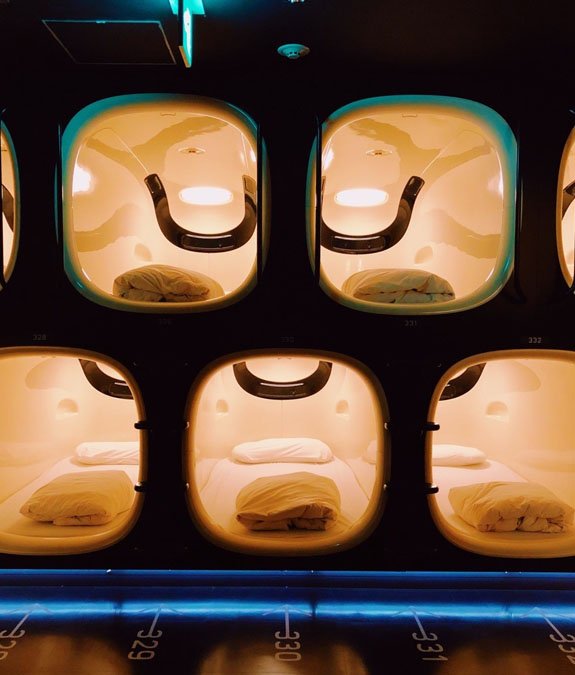
°C Sauna + Sleep
Inspired by Scandinavian wellness traditions, this concept capsule hotel – pronounced “Do-C” – features an on-site sauna. Stays are limited to one night and facilities are separate for men and women. Located in Ebisu.
1-8-1 Ebisu, Shibuya-ku, Tokyo 150-0013
Rates from ¥4,900 ($44)
Oedo Onsen Motogari
Often called an “onsen theme park,” this extensive onsen (hot spring) facility hosts guests overnight. There is a large, on-site food court where you can sample foods from all across Japan. If you have any visible tattoos, this is not the place for you, as they are forbidden in the onsen area (as is tradition in most of Japan). Located in Odaiba.
2-6-3 Aomi, Koto-ku, Tokyo 135-0064
Rates from ¥4,436 ($40)
Mid-Range Accommodations
Hotel Koé
Hotel Koé is more than an accommodation. This hotel is a concept space with a public shopping area, gallery, performance space, café, and restaurant. The rooms are ultra-modern and ideal for those who enjoy sleek interior design. Located in Shibuya.
3-7 Udagawa, Shibuya-ku, Tokyo 150-0042
Rates from ¥21,591 ($194)
Sukeroku no Yado Sadachiyo
The Sadachiyo ryokan is the perfect accommodation for an authentic Japanese lodging experience in Tokyo. This is your opportunity to sleep on tatami-matted floors with traditional futons and access the relaxing on-site onsen (hot spring). Located in Asakusa.
2-20-1 Asakusa, Taito-ku, Tokyo 111-0032
Rates from ¥14,100 ($127)
Claska Hotel
This western-style hotel offers the hospitality of an inn and the services and atmosphere of a luxury establishment. Once a traditional Japanese hotel, Claska retains the minimalism of Japanese tradition while being familiar enough for tourists to feel at home. Located in Meguro.
1-3-18 Chuo, Meguro-ku, Tokyo, 152-0001
Rates from ¥13,000 ($117)
Bed & Art Hotel (BnA)
Each room in this independent art hotel is decorated by a different Japanese artist. The hotel also features a bar, gallery, and rooftop lounge. Located in Koenji and Akihabara (rates are higher at Akihabara).
2-4-7 Koenjikita, Suginami-ku, Tokyo 166-0002
Rates from ¥16,000 ($144)
Luxury Accommodations
Hoshinoya
Live like a Meiji emperor in Tokyo’s first luxury ryokan. This 17-story establishment features private baths in each room, in addition to the onsen (hot spring) available to all guests. Located in Otemachi.
1-9-1 Otemachi, Chiyoda-ku, Tokyo 100-0004
Rates from ¥67,200 ($604.50)
Park Hyatt Tokyo
Famously featured in Sofia Coppola’s Lost in Translation, the Park Hyatt is a favorite of luxury travelers to Tokyo. The hotel features a bar, indoor pool, and fitness facility, each with panoramic views of the city. Located in Shinjuku.
3-7-1-2, 3-7 Nishi-Shinjuku, Shinjuku-ku, Tokyo 163-1055
www.hyatt.com/park-hyatt-tokyo
Rates from ¥90,000 ($809.50)
The Ritz Carlton Tokyo
The Ritz Carlton is located in Tokyo’s tallest residential building, from which you can see Mt. Fuji on a clear day. As one of the world’s preeminent luxury hotel brands, you can expect fine dining, a relaxing spa, and impeccable hospitality. Located in Akasaka.
Tokyo Midtown Building, 9-7-1, Akasaka, Minato-ku, Tokyo 107-6245
Rates from ¥122,500 ($1,102)
Near Ajinomoto Stadium
Creston Hotel
This budget hotel is an easy walk to the stadium in Chofu, making it a perfect option for sports tourists planning on catching a soccer or rugby match in Tokyo. Because it has a carpark, Creston Hotel is also a good home base for people who plan on renting cars for traveling outside of Tokyo. Located in Chofu.
1-38-1 Kojima, Chofu-shi, Tokyo 182-0026
Rates from ¥11,389 ($102)
Hotel Musashino no Mori
The Musashino “Forest” Hotel is a convenient accommodation for sightseeing in outer Tokyo. Western and Japanese-style rooms are available and full and half board are optional. Located in Fuchu.
6-12-8 Shiraitodai, Fuchu, Tokyo 183-0011
www.tokyowest-hotel.co.jp/musashino/
Rates from ¥4,500 ($40.50)
Full Board vs Half Board: What’s the Difference?
Full Board – Typically includes bed, breakfast, packed lunch, and an evening meal
Half Board – Typically includes bed, breakfast, and an evening meal (but no packed lunch)
Keio Plaza Hotel
If you’re planning on visiting the Ajinomoto Stadium, but want to stay in the city center, the Keio Plaza Hotel at Shinjuku Station is in a convenient location. Twenty minutes on the Keio Line will get you from the stadium to the hotel. This hotel is known for some of its rooms’ colorful Hello Kitty themes. Located in Shinjuku.
2-2-1 Nishi-Shinjuku, Shinjuku-Ku, Tokyo 160-8330
Rates from ¥23,275 ($209)
What to Do in Tokyo
Now that you’ve settled the logistics, it’s time to start planning your itinerary. Tokyo is truly a city with limitless possibilities when it comes to attractions and entertainment. To make your travel preparations easier, here are some recommendations for how to fill your days.
Art & Culture
TeamLab is a Tokyo-based digital art collective that’s shaping the face of modern art. They have trendy, immersive exhibitions worldwide, but their home is in Odaiba’s Palette Town.
Address: Odaiba Palette Town, 1-3-8 Aomi, Koto-ku, Tokyo 135-0064
Hours: Mon-Fri 10AM-7PM, Sat/Sun/Holidays 10AM-9PM ; Closed the second and fourth Tuesdays of the month
Access: Tokyo Teleport Station (JR Rinkai Line) Aomi Station (New Transit Yurikamome Line)
Cost: ¥3,200 ($28.80)
Yayoi Kusama is one of Japan’s most celebrated modern artists. Her artwork is displayed all throughout the country, but her largest collection is in Tokyo.
Address: 107 Bentencho, Shinjuku-ku, Tokyo 162-0851
Hours: Thu-Sun/Holidays 11AM-5:30PM
Access: Waseda Station (Tokyo Metro Tozai Line)
Ushigome Yanagicho Station (Toei Subway Oedo Line)
Cost: ¥1,000 ($9) *tickets must be purchased online before the date
Shopping
This iconic department store is responsible for the gyaru fashion style that is popular in Shibuya. Shop costumes, wigs, and other fun attire.
Address: 2-29-1 Dogenzaka, Shibuya-ku, Tokyo 150-0043
Hours: Mon-Sun 10AM-9PM
Access: Shibuya Station (JR Shonan-Shinjuku, Saikyu, Yamanote Lines, Tokyo Metro Ginza, Fukutoshin, Honzomon Lines, Keio Inokashira Line, Tokyu Denentoshi, Toyoko Lines)
Cost: Free Entry
The National Art Center Tokyo Gift Shop
The National Art Center Tokyo is a fantastic place to see a rotating exhibit, but it’s also a one-stop shop for unique Japanese gifts. Great for finding artisanal products from Tokyo creators.
Address: 7-22-2 Roppongi, Minato, Tokyo 106-8558
Hours: Sun-Thu 10AM-6PM, Fri-Sat 10AM-8PM
Closed Tuesdays (except holidays)
Access: Nogizaka Station (Tokyo Metro Chiyoda Line)
Roppongi Station (Tokyo Metro Hibiya Line, Toei Oedo Line)
Cost: Free Entry
The Japanese take their stationery very seriously. Come explore the best office goods Tokyo has to offer, shop for fine stationery, and order custom notebooks at Kakimori.
Address: 1-6-2, Misuji, Taito-ku, Tokyo 111-0055
Hours: Tue-Sun 11AM-7PM
Access: Kuramae Station (Tokyo Metro Asakusa Line, Toei Oedo Line)
Asakusabashi Station (JR Chuo-Sobu Line, Tokyo Metro Asakusa Line)
Cost: Free entry
Cultural Experiences
Come see a performance of traditional Japanese kabuki theater in Ginza. English captions are available.
PRO TIP: Kabuki performances are divided into five acts. Save money by opting for Hitomaku-mi (single-act) tickets.
Address: 4-12-15 Ginza, Chuo-ku, Tokyo 104-0061
Hours: Daily shows at 11AM, 4:30PM
Access: Higashi Ginza Station (Tokyo Metro Hibiya Line, Asakusa Line)
Ginza Station (Tokyo Metro Ginza, Marunouchi Line, Hibiya Lines)
Cost: Full show for ¥4,000-¥20,000 ($36-$180), Hitomaku-mi (single-act) tickets for ¥500-¥3,000 ($4.50-$27)
This multi-art school is where to go to participate in Japanese culture by learning a traditional art form. You may have the opportunity to learn batto (Japanese swordsmanship), shodo (calligraphy), waso (kimono dressing), and sado (tea ceremony).
Address: 4-3-13 Ginza, Chuo-ku, Tokyo 104-0061
Hours: Mon-Sun 10AM-8:15PM
Access: Ginza Station (Tokyo Metro Ginza, Marunouchi Line, Hibiya Lines
Yurakucho Station (JR Yamanote, Keihin-Tohoku Lines, Tokyo Metro Yurakucho Line)
Cost: From ¥10,000 ($90) for a 30-45-minute lesson
This four-story-tall sento (public bath facility) is one of the most popular bathhouses in the city. Opened in 2016, the facilities are clean, comfortable, and relaxing.
Address: 2-13-13 Negishi, Taito-ku, Tokyo 110-0003, Japan
Hours: Mon-Sun 6AM-9AM, 11AM-1AM
Closed the third Tuesday of the month
Access: Uguisudani Station (JR Yamanote, Keihin-Tohoku Lines)
Uguisudani Ekimae bus stop (Toei Bus)
Cost: ¥460 ($4.15)
Head to the Tokyo Whiskey Library in Omotesando to imbibe in Japanese craft whiskey. Here you can sample some of the country’s finest whiskeys.
Address: 5-5-24 Minimi Aoyama, Minato-ku, Tokyo, 107-0062
Hours: Mon-Fri 6MP-3AM, Sat 3PM-3AM, Sun 3PM-Midnight
Access: Omotesando Station (Tokyo Metro Ginza Line, Honzoman Line, Chiyoda Line)
Cost: Free entry
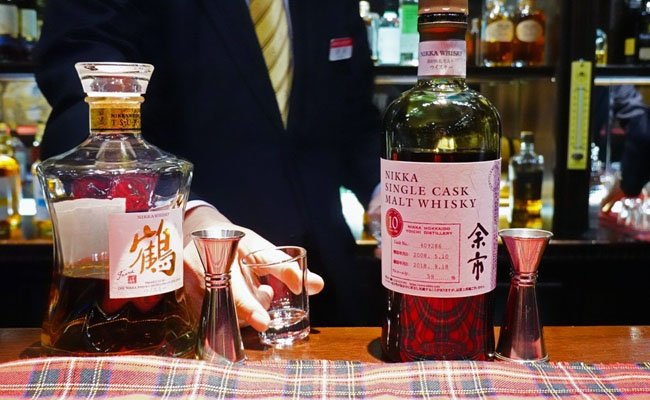
Sushi lovers can’t miss the opportunity to make sushi with the masters. All fish comes fresh from the nearby Tsukiji Fish Market.
Address: Tsukiji KY Building 2F, 4-7-5 Tsukiji, Chuo-ku, Tokyo 104-0045
Hours: Saturdays at 9AM, 1PM, 3PM
Access: Tsukiji Station (Tokyo Metro Hibiya Line)
Tsukiji Shijo Station (Toei Oedo Line)
Cost: ¥5,000 ($45) for a 90-minute course
Offbeat Activities
One of hundreds, if not thousands, of karaoke joints in Tokyo. No trip to Tokyo is complete with a cathartic karaoke session.
Address: 1-5-12 Nishi Shinjuku, Shinjuku-ku, Tokyo 160-0023
Hours: Mon-Sun Noon-5AM
Access: Shinjuku Station (JR Yamanote, Chuo, Chuo-Sobu, Saikyo, Shonan-Shinjuku Lines, Tokyo Metro Marunouchi Line, Toei Shinjuku, Oedo Lines, Odakyu Odawara Line, Seibu Shinjuku Line)
Cost: ¥175 ($1.60) for 30 minutes (Mon-Thu before 7pm)
¥1,985 ($17.90) for all night (Mon-Thu)
¥2,650 ($23.80) for all night (Fri-Sun)
Skip Akihabara and get your geek fix at this shopping mall, where you’ll also find the pop-art-inspired café of Takashi Murakami’s creation, Bar Zingaro.
Address: 5-52 Nakano, Nakano-ku, Tokyo 164-0001
Hours: Mon-Sun 11AM-8PM
Access: Nakano Station (JR Chuo, Chuo-Sobu Lines, Tokyo Metro Tozai Line)
Cost: Free entry
You may find cat cafés all over the city, but for a truly unique experience, visit the Akihabara owl café. The space is intended to be a peaceful healing zone – that means no phones allowed.
Address: 67 Kanda Neribeicho, Chiyoda-ku, Tokyo 101-0022
Hours: Mon, Wed-Sun 12PM-7PM (by reservation only)
Closed Tuesdays
Access: Akihabara Station (JR Yamanote, Keihin-Tohoku, Chuo-Sobu Lines, Tokyo Metro Hibiya Line)
Cost: ¥2,000 ($18)
For a Breath of Fresh Air
Not far from the Harajuku neighborhood is a sprawling Western-style park. Yoyogi Park is ideal for picnicking, people-watching, and relaxing in nice weather.
Address: 2-1 Yoyogikamizonocho, Shibuya-ku, Tokyo 151-0052
Hours: Mon-Sun 5AM-8PM
Access: Harajuku Station (JR Yamanote Line)
Yoyogi-Koen Station (Tokyo Metro Chiyoda Line)
Meiji-jingumae Station (Tokyo Metro Chiyoda, Fukutoshin Lines)
Yoyogi Hachiman Station (Odakyu Line)
Cost: Free entry
The most visited mountain in the world, Mount Takao sits just a train ride away on the outskirts of the Greater Tokyo Area. This is your chance to leave the city and reconnect with nature.
Address: Takaomachi, Hachioji, Tokyo 193-0844
Hours: 24/7
Access: Takaosanguchi Station (Keio Takao Line)
Cost: Free entry
In the moat along the Imperial Palace, you can rent colorful rowboats for a romantic afternoon. The best time to do this is during sakura season, as the cherry blossoms hang overhead.
Address: 1−2 Kojimachi, Chiyoda-ku, Tokyo 102-0082
Hours: Tue-Sun 11AM-4:30PM
Access: Kudanishita Station (Tokyo Metro Tozai, Hanzomon Lines, Toei Shinjuku Line)
Hanzomon Station (Tokyo Metro Hanzomon Line)
Cost: ¥1,000 ($9) for 60 minutes
Tokyo Dining: Classic Dishes & Where to Eat Them
Tokyo is heaven for foodies. Sure, it may have more Michelin stars than any other city, but here, even the average hole-in-the-wall serves up world-class meals. The ritual of food preparation in this city is as revered as its matsuri (cultural festivals), especially when it comes to Tokyo’s most emblematic dishes.
Because it has been the seat of international trade for the last 200 years, Tokyo’s cuisine has largely shaped the world’s conception of Japanese food. Sushi, tempura, and ramen, for example, all come from the bustling capital. But those aren’t the only local specialties. Here’s the Tokyo city guide to traditional dishes and where to try them for yourself.
Edo-Style Sushi
Sushi has never been unique to Tokyo, but Tokyo’s Edo-style sushi, or Edomaezushi, inspired the sushi most people recognize today. Unlike sosaku sushi, or “creative sushi,” which incorporates multiple ingredients (think California roll or spider roll), Edo-style sushi focuses on single flavors. It is also known for its incorporation of wasabi.
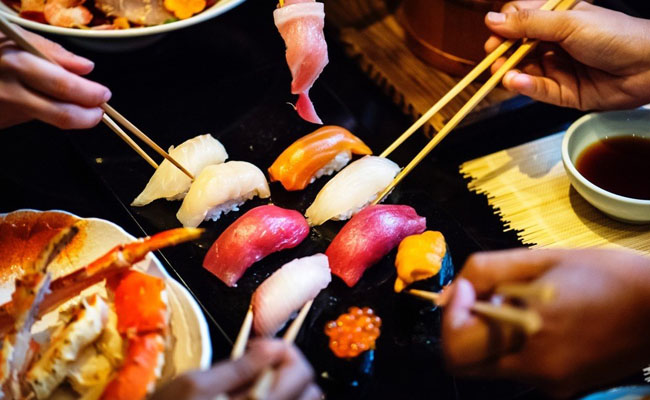
Where to Eat Edo-Style Sushi Like a Local:
Sushi Dai
Address: 6-5-1 Toyosu, Koto-ku, Tokyo 135-0061
Hours: Mon-Sat 5:30AM-2PM
Access: Tsukiji Shijo Station (Toei Oedo Line)
Tsukiji Station (Tokyo Metro Hibiya Line)
Price Range: ¥2,500-¥4,000 ($22.50-$36)
Reservations Available: No
PRO TIP: Go for sushi breakfast after visiting the Tsukiji Fish Market.
Where to Eat Michelin-Starred Edo-Style Sushi:
Sushi Matsuda
Address: 5-8-11 Minami Aoyama, Minato-ku, Tokyo
Hours: Mon-Sat 12PM-2PM, 5:30PM-10PM
Access: Omotesando Station (Tokyo Metro Chiyoda, Ginza, Honzomon Lines)
Price Range: ¥35,000 ($314.80)
Reservations: Required
Shoyu Ramen
Since ramen made its way to Japan from China in the late 17th century, it has been uniquely adapted in each of Japan’s regions. Tokyo’s take on the trendy dish is called Shoyu (soy sauce) ramen for its soy sauce-flavored broth. The noodles are traditionally topped with pork slices, half an egg, and sliced leeks.
Where to Eat Shoyu Ramen Like a Local:
Shibasakitei Chofu
Address: 3-25-52 Nishi Tsutsujigaoka, Chofu, Tokyo 182-0006
Hours: Tue-Fri 11AM-2PM, 6PM-12AM, Sat/Sun/Holidays 11AM-4PM
Access: Tsutsujigaoka Station (Keio Line)
Price Range: ¥500-¥600 ($4.50-$5.40)
Reservations Available: No
*Close to Ajinomoto Stadium
Where to Eat Michelin-Starred Shoyu Ramen:
Sobahouse Konjiki
Address: 2-4-1 Shinjuku, Shinjuku-ku, Tokyo 160-0022
Hours: Tue-Sun 11:30AM-3PM, Tue-Sat 6:30PM-9:30PM
Access: Shinjuku-gyoenmae Station (Tokyo Metro Marunouchi Line)
Shinjuku-sanchome Station (Tokyo Metro Marunouchi, Fukotoshin Lines, Toei Shinjuku Line)
Price Range: ¥850-¥1,200 ($7.60-$10.80)
Reservations Available: No
Soba
Soba can be intimidating to foreigners who don’t know how to eat it. Most people are familiar with the ramen-like soup, but soba is also eaten cold. When served cold, the thick buckwheat noodles (naturally gluten-free) are sprinkled with toppings like leeks or nori (seaweed) and dipped in an accompanying bowl of daikon (Japanese radish) broth.
Where to Eat Soba Like a Local:
Kanda Yabu Soba
Address: 2-10 Kanda Awajicho, Chiyoda-ku, Tokyo 101-0063
Hours: Mon-Tue, Thu-Sun 11:30AM-8:30PM
Closed Wednesdays and holidays
Access: Ochanomizu Station (JR Chuo, Chuo-Sobu Lines, Tokyo Metro Marunouchi Line)
Awajicho Station (Tokyo Metro Marunouchi Line)
Kanda Station (JR Keihin-Tohoku, Yamanote, Chuo Lines, Tokyo Metro Ginza Line)
Price Range: ¥700-¥1,800 ($6.30-$16.20)
Reservations Available: Yes
Where to Eat Michelin-Starred Soba:
Tamawari
Address: 5-23-3 Jingumae, Shibuya-ku, Tokyo 150-0001
Hours: (Lunch) Tue-Fri 11:30AM-3PM, Sat 11:30AM-8PM, Sun 11:30AM-5PM
(Dinner) Tue-Sat 6:30PM-9:30PM
Closed Mondays, open holidays
Access: Meiji-jingumae Station (Tokyo Metro Chiyoda, Fukutoshin Line)
Price Range: ¥2,000-¥4,000 ($18-$36) for lunch, ¥3,000-¥10,000 ($27-$90) for dinner
Reservations Available: Yes
Tempura
Tempura was born in Tokyo in the 16th century after traders from Portugal introduced the concept of frying foods in oil. The fried fish, seafood, and vegetables became a popular fast food during the Meiji Restoration of Tokyo, when street food vendors began selling it with rice or noodles. The rice and tempura dish, called tendon, is still very popular across the city, though tempura is just as tasty when eaten by itself.
Where to Eat Tempura Like a Local:
Dote no Iseya
Address: 1-9-2 Nihonzutsumi, Taito-ku, Tokyo 111-0021
Hours: 11AM-2:30PM
Closed Wednesdays, holidays, fourth Tuesday of the month
Access: Minowa Station (Tokyo Metro Hibiya Line)
Price Range: ¥1,500-¥2,500 ($13.50-$22.50)
Reservations Available: No
Where to Eat Michelin-Starred Tempura:
Mikawa Zenzankyo
Address: 1-3-1 Fukuzumi, Koto-ku, Tokyo 135-0032
Hours: Mon-Tue, Thu-Sun 11:30AM-1:30PM, 5PM-9PM
Closed Wednesday
Access: Monzen-Nakacho Station (Tokyo Metro Tozai Line, Oedo Lines)
Price Range: ¥18,000 ($161.90) for lunch, ¥20,000 ($180) for dinner
Reservations: Required + ¥10,000 ($90) per-person deposit
Monjayaki
One dish that hasn’t gained popularity overseas (yet) is monjayaki, often simply called monja. Tokyo’s equivalent of Kansai’s okonomiyaki, monja is made of finely-chopped vegetables and seafood in a watery batter, cooked on a teppan grill. At monja restaurants, ingredients usually come in a bowl for the customers to prepare for themselves. There are currently no Michelin-rated monjayaki restaurants.
Where to Eat Monjayaki Like a Local:
Kondo Honten
Address: 3-12-10 Tsukishima, Chuo-ku, Tokyo 104-0052
Hours: Mon-Fri 5PM-10PM, Sat/Sun/holidays 12PM-10PM
Access: Tsukishima Station (Tokyo Metro Yurakucho Line, Toei Oedo Line)
Price Range: ¥1,500 ($13.50) for lunch, ¥2,500 ($22.50) for dinner
Reservations Available: Yes
PRO TIP: This restaurant is located in the Tsukishima neighborhood, home to Tokyo’s famous “Monja Street.”
Unagi no Kabayaki
Unagi, or freshwater eel, is a favorite among Japanese. It’s especially popular in Tokyo, the home of unagi no kabayaki (grilled eel). This dish is prepared by coating fresh eel in unagi sauce and grilling it over charcoal. Despite its humble origins as a street food, you can now find it in many fine establishments, including seven Michelin-starred restaurants.
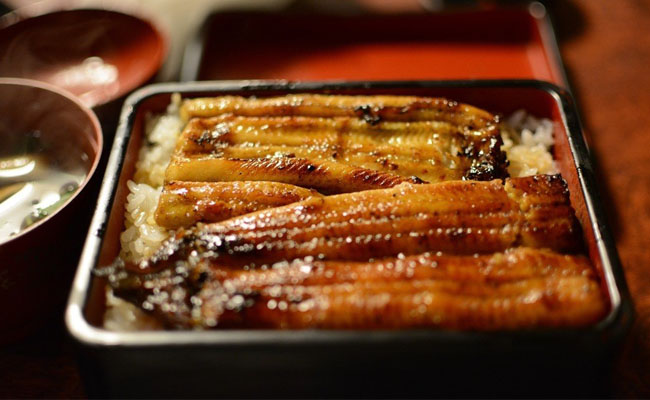
Where to Eat Unagi no Kabayaki Like a Local:
Kawachiya
Address: 7-6-16 Shibamata, Katsushika-ku, Tokyo, 125-0052
Hours: Mon-Sun 11AM-7PM
Access: Shibamata Station (Keisei Kanamachi Line)
Kanamachi Station (JR Joban Line)
Koiwa Station (JR Chuo-Sobu Line)
Price Range: ¥3,500 ($31.50)
Reservations Available: Yes
Where to Eat Michelin-Rated Unagi no Kabayaki:
Unagi Hashimoto
Address: 2-5-7 Suido, Bunkyo-ku, Tokyo 112-0005
Hours: Mon-Wed, Fri-Sun 11:30AM-2PM, 4:30PM-8PM
Closed Thursdays, once a month on Wednesday
Access: Edogawabashi Station (Tokyo Metro Yurakucho Line)
Price Range: ¥3,100-¥5,400 ($27.90-$48.60)
Reservations Available: Yes
Where to Go for an “Only in Tokyo” Dining Experience
Tokyo is a city renowned for its inherent contradictions, where you can witness cultures clashing at every corner. So, while traditional cuisine maintains its importance in the city, Tokyo is also the breeding ground for plenty of weird and wacky concept dining experiences. Incorporating modern themes such as pop culture and technology, these concept restaurants and cafes represent the more flamboyant side of the city.
The Robot Restaurant
It may be one of the biggest tourist traps in Tokyo, but it’s hard to say no to the allure of Shinjuku’s Robot Restaurant. Lasers, robots, dancers, and taiko drummers all flit around a compact runway for your entertainment.
Don’t be fooled by the name, though; it’s more of a show than a restaurant. Say “no” to the bento dinner option and grab a late-night bite elsewhere once the show ends.
Address: 1-7-7 Kabukicho, Shinjuku-ku, Tokyo 160-0021
Hours: Mon-Sun at 4PM, 5:55PM, 7:50PM, and 9:45PM
Access: Shinjuku Station (JR Yamanote, Chuo, Chuo-Sobu, Saikyo, Shonan-Shinjuku Lines, Tokyo Metro Marunouchi Line, Toei Shinjuku, Oedo Lines, Odakyu Odawara Line, Seibu Shinjuku Line)
Price Range: ¥7,500 ($67.50)
Reservations: Recommended
Kawaii Monster Café
Conceived by Japanese artist and designer Sebastian Matsuda, the Kawaii Monster Café is the perfect representation of its home neighborhood, Harajuku. Visiting this café is like diving down the rabbit hole – it’s separated into four trippy zones and hosted by an improbable cast of characters that look like they were born in a fever dream.
The café’s dishes are just as mind-boggling as the décor. Chocolate chicken and colorful poison cake are just a couple items on the menu.
Address: YM Square 4F, 4-31-10 Jingumae, Shibuya-ku, Tokyo 150-0001
Hours: Mon-Sat 11:30AM-4:30PM, 6PM-10:30OM, Sun/holidays 11AM-8PM
Access: Meiji-jingumae Station (Tokyo Metro Chiyoda, Fukutoshin Lines)
Omotesando Station (Tokyo Metro Chiyoda, Ginza, Honzomon Lines)
Price Range: ¥1,000-¥2,000 ($9-$18) for lunch, ¥2,000-¥4,000 ($18-$36) for dinner
Reservations: Recommended
Genki Sushi
Genki Sushi is Tokyo’s preeminent conveyor belt sushi restaurant. Customers sit at a bar facing the conveyor belt, where they order sushi, maki (sushi and raw vegetables wrapped in seaweed), or small dishes like yakitori (skewered meats) on a tablet. This cheap, novel experience is a tourist favorite, especially among solo travelers who feel at home among other single diners.
Address: Leisure Plaza Building 1F, 24-8 Udagawa, Shibuya-ku, Tokyo, 150-0042
Hours: Mon-Sun 11AM-12AM
Access: Shibuya Station (JR Shonan-Shinjuku, Saikyu, Yamanote Lines, Tokyo Metro Ginza, Fukutoshin, Honzomon Lines, Keio Inokashira Line, Tokyu Denentoshi, Toyoko Lines)
Price Range: ¥600-¥1,100 ($5.40-$9.90)
Reservations Available: No
Sakura Tei
This indoor-outdoor establishment buried in the backstreets of Harajuku is the largest okonomiyaki (grilled cabbage pancake) restaurant in Tokyo. The colorful interior, cheap drinks, and convivial environment make it a great place to visit with friends and taste the beloved Kansai dish.
Address: 3-20-1 Jingumae Shibuya-ku, Tokyo 150-0001
Hours: Mon-Sun 11AM-11PM
Access: Meiji-jingumae Station (Tokyo Metro Chiyoda, Fukutoshin Lines)
Omotesando Station (Tokyo Metro Chiyoda, Ginza, Honzomon Lines)
Price Range: ¥1,000-¥1,500 ($9-$13.50)
Reservations Available: No
Shirohige’s Cream Puff Factory
This tiny bakery in the Setagaya neighborhood of Tokyo, not far from Shimokitazawa, is a garden hideaway and the perfect spot for afternoon tea. It was opened by the sister-in-law of Hayao Miyazaki, the creator of the acclaimed animation studio known as Studio Ghibli. The bakery and café’s main attraction is its adorable cream puff in the shape of Totoro, Ghibli’s most popular character.
Address: 5-3-1 Daita, Setagaya-ku, Tokyo 155-0033
Hours: Mon-Sun 10:30AM-7PM
Access: Setagaya-Daita Station (Odakyu Odawara Line)
Shin-Daita Station (Keio Inokashira Line)
Shimokitazawa Station (Odakyu Odawara Line, Keio Inokashira Line)
Price Range: ¥400 ($3.60)
Reservations Available: No
Zauo Fishing Restaurant
This is your opportunity to see if a fish really does taste better when you’ve caught it yourself. A visit to Zauo comes in two parts: first, sit in the fishing area, cast your line into the pool of live fish, and wait for something to bite. Next, hand over your catch to the chefs, who will prepare it however you desire. Beware: it may take a while for a fish to bite.
Address: 3-2-9 Nishi Shinjuku, Shinjuku-ku, Tokyo 160-0023
Hours: Mon-Fri 11:30AM-2PM, 5PM-11PM, Sat/Sun/holidays 11AM-11PM
Access: Tochomae Station (Toei Oedo line)
Price Range: ¥4,000-¥7,500 ($36-$67.50)
Reservations Available: Yes
Where (and What) to Drink in Tokyo
Don’t be fooled by their conservative demeanor; the Japanese love to drink. In addition to its revered cuisine, Tokyo has a thriving drinking culture that imbues everyday life. As soon as the work day ends, you will see the bars fill up with happy hour patrons and you might even catch a suited businessman sipping a can of chuhai (Japanese alcoholic soft drink) on the train ride home.
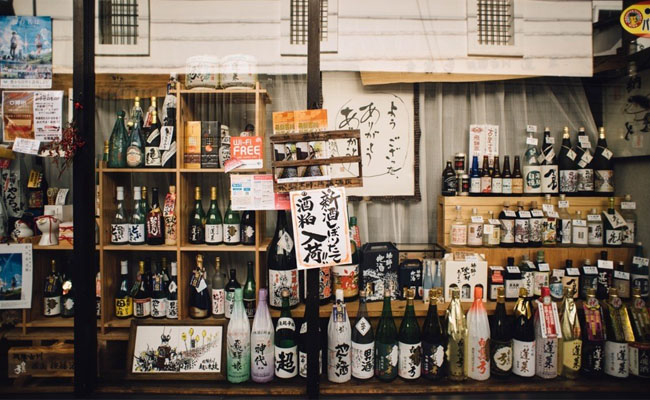
Most of the time you’ll see Tokyoites drinking beer, the preferred alcohol of the Japanese. But you’ll be missing out if you stick to Asahi and Kirin. As this Tokyo City Guide explains, Japan has many other unique liquors to try. These are the Japanese drinks you need to taste and where to find them in Tokyo.
*You must be 20 years old to drink alcohol in Japan.
Sake
Sake, Japanese rice wine, is one of the most popular Japanese liquors for foreigners. You can drink it hot for a drier flavor, or cold to pair it with sweet foods. Different designations, like Honjozo or Daiginjo represent how polished the rice grains are before fermentation, and the title Junmai (literally, “pure rice”) means that no additional alcohol was added in the process. Sake has an alcohol content of 10-20%.
Try Sake Here:
Junmaisu Yata
Address: ILA Dogenzaka Building 5F, 1-6-9 Dogenzaka, Shibuya-ku, Tokyo 150-0043
Hours: Mon-Fri 4PM-11:30PM, Sat-Sun 3PM-10:30PM
Access: Shibuya Station (JR Yamanote Line, Denentoshi Line, Toyoku Line, Ginza Line, JR Shonan-Shinjuku Line, JR Saikyo Line, Keio Inokashira Line, Hanzomon Line, Fukutoshin Line)
Price Range: ¥500 ($4.50) by the glass, ¥2,000 ($18) all-you-can-drink
Shochu
Shochu is a Japanese distilled liquor similar to vodka or brandy and made of grains and vegetables such as barley, rice, buckwheat, and sweet potatoes. With an alcohol content of 20-40%, drinking shochu on its own is not for the faint of heart. It’s usually cut with a mixer like tea, juice, or sparkling water.
Try Shochu Here:
Havespi
Address: 3-9-9, Shinjuku, Shinjuku-ku, Tokyo, 160-0022
Hours: Mon-Fri 5PM-11Pm, Sat/Sun/holidays 12PM-4PM, 5PM-11PM
Access: Shinjuku-sanchome (Tokyo Metro Fukutoshin Line, Marunouchi Line, Shinjuku Line)
Price Range: ¥3,000 ($27) all-you-can-drink
Whiskey
Japan has risen to the top rungs of whiskey manufacturers around the world, and in short time, too. In fact, whiskey aficionados regularly make the trip to Tokyo to get a taste of some of the best and most exclusive whiskeys from top producers like Nikka and Suntory.
Try Japanese whiskey here:
Nikka Blender’s Bar
Address: 5-4-31 Minami Aoyama Minato-ku, Tokyo 107-0062
Hours: Mon-Sat 5PM-11:30PM
Closed Sundays and holidays
Access: Omotesando Station (Tokyo Metro Chiyoda, Ginza, Honzomon Lines)
Price Range: ¥3,000 ($27) for a tasting set
Umeshu
Fans of sweet liquors will love umeshu, Japanese plum wine. It’s widely produced, but many Japanese also make it at home. The sweet drink is served on the rocks and is particularly popular with those who don’t usually enjoy drinking alcohol.
Try Umeshu Here:
Bar Gen & Materiel
Address: 2-9-10 Dogenzaka, Shibuya-ku, Tokyo 150-0043
Hours: Mon-Sun 5PM-12AM
Access: Shibuya Station (JR Shonan-Shinjuku, Saikyu, Yamanote Lines, Tokyo Metro Ginza, Fukutoshin, Honzomon Lines, Keio Inokashira Line, Tokyu Denentoshi, Toyoko Lines)
Price Range: ¥1,200 ($10.80) for a three-glass flight
Cocktails
In Tokyo, cocktail culture is venerated. Seriously, you’ve never seen cocktails served like this before. Cocktail-making is treated as a sacred craft in this city, where bartenders even take the time to hand-chisel balls of ice to perfection.
Try Artisanal Cocktails Here:
Bar Benfiddich
Address: Yamatoya Building 9F, 1-13-7 Nishi Shinjuku, Shinjuku-ku, Tokyo 160-0023
Hours: Mon-Sat 6PM-3AM
Closed Sundays and holidays
Access: Shinjuku Station (JR Yamanote, Chuo, Chuo-Sobu, Saikyo, Shonan-Shinjuku Lines, Tokyo Metro Marunouchi Line, Toei Shinjuku, Oedo Lines, Odakyu Odawara Line, Seibu Shinjuku Line)
Price Range: ¥1,500-¥2,000 ($13.50-$18) per cocktail
Craft Beer
The craft beer scene in Tokyo has exploded in the last decade. Avoid the big names in Japanese beer and try one of the many microbrews brewed locally in Tokyo, like Baird. Because craft beers have long been popular with foreigners, craft beer bars in Tokyo usually provide an interesting setting for Japanese and foreigners to come together and exchange.
Try a Tokyo Microbrew Here:
Popeye
Address: 2-18-7 Ryogoku, Sumida-ku, Tokyo 130-0026
Hours: Mon-Sat 5:30PM-11:30PM, Sun 3PM-11:30PM
Access: Ryogoku Station (JR Chuo-Sobu Line, Tokyo Oedo Line)
Price Range: ¥500-¥1,000 ($4.50-$9) per glass
Tokyo Itinerary Ideas
With so many things to do and places to discover, planning your trip to Tokyo can feel overwhelming. Keep in mind, you’ll be ten times more overwhelmed if you arrive with no plans at all and no idea where to begin.
Also, many activities require booking in advance. So, to make your travel planning a little easier, here are some sample itineraries for inspiration.
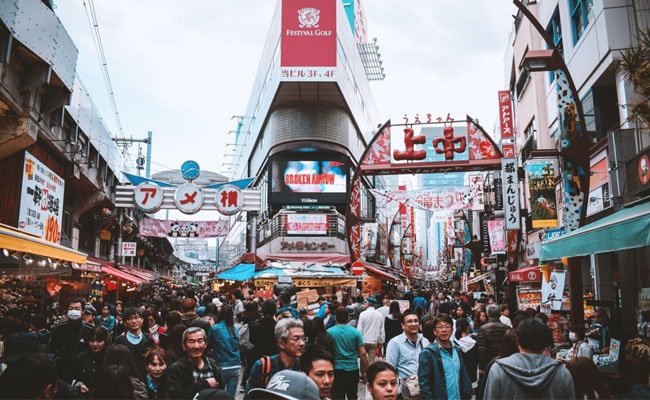
One Day: Central Tokyo
-
If Tokyo is just a one-day stop on your Japan travel itinerary, keep it simple and stick to central Tokyo. Choose no more than three neighborhoods on the JR Yamanote Line to explore. Then stop for a mid-day break at Yoyogi Station and take a breather at Yoyogi Park.
One Week: Central Tokyo and the Greater Tokyo Area
-
Day 1: Give your trip context by exploring Tokyo’s roots in Asakusa. Then spend the evening relaxing at an onsen, like the nearby Jokotsuya.
-
Day 2: Hop on the Water Bus and go sightseeing along the Sumida River. When you arrive in Odaiba, head to Palette Town and see digital art at teamLab borderless.
-
Day 3: Stroll the stalls and have sushi breakfast at the Tsukiji Fish Market. Then head over to Ginza and catch an act or two at the Kabukiza Theatre.
-
Day 4: Get your pop culture fix in Shibuya. Then take a walk north to the next-door neighborhood of Harajuku for some shopping and to satisfy your sweet tooth.
-
Day 5: Leave the city center to visit Chofu. Grab some ramen at Shibasakitei, then marvel at the flowers of Jindai Botanical Gardens. End the day watching an evening rugby match at Ajinomoto Stadium.
-
Day 6: Get to know the Tokyo art scene at Roppongi’s Mori Art Museum or the National Art Center Tokyo. Then spend your last night singing your heart out at a Shinjuku karaoke joint.
-
Day 7: Grab a souvenir from one of the Shinjuku department stores before saying goodbye to the city from the observation deck at the Tokyo Metropolitan Government Building Observation Deck.
Two Weeks: Greater Tokyo Area and Nikko
-
Day 1: Dive right into the heart of the lively city by getting to know Shinjuku. Between wandering the streets of izakayas (Japanese gastropubs) and department stores, admire the Japanese gardens of Shinjuku Gyoen.
-
Day 2: See an exhibition at one of the museums in Roppongi and go shopping for unique creations at National Art Center Tokyo.
-
Day 3: Head to Kichijoji to see how real Tokyoites live. Spend the afternoon relaxing at Inokashira Park before munching on yakitori (Japanese skewers) and sashimi (sliced raw fish) for dinner at the park’s local izakaya (tavern), SubLime.
-
Day 4: After visiting the Tsukiji Fish Market, head south toward Tokyo Bay to discover the attractions of Odaiba.
-
Day 5: Take a city break and hop on the Keio Line toward Mount Takao. Spend the day hiking and maybe even say hello to the macaques at the Mt. Takao Monkey Park.
-
Day 6: Visit Akihabara to see just how ubiquitous geek culture is in Tokyo. In the evening, walk over to Ueno and grab a street food dinner at the Ueno Ameyoko night market.
-
Day 7: Get to know the origins of Tokyo in Asakusa, the cultural center of the city. Just before sunset, hop on the elevator that takes you to the observation deck of Tokyo Skytree and see if you can spot Mt. Fuji.
-
Day 8: Escape Tokyo for the day and take a day trip to Nikko, where you’ll see breathtaking nature and magnificent shrines.
-
Day 9: Take the opportunity to participate in Japanese culture by taking a class at HiSui Tokyo.
-
Day 10: Be hip and go thrift shopping in Shimokitazawa. In the afternoon, walk to Shirohige’s Cream Puff Factory for afternoon tea and a kawaii (“cute”) pastry.
-
Day 11: Spend the day focusing on your well-being at Oedo Onsen Monogatari, where you can split your time between the onsen (hot springs) and the food stalls.
-
Day 12: Dedicate the day to pop culture in Shibuya and Harajuku. Maybe even buy a costume and be someone else for a day. Half the people in Harajuku are in cosplay anyway.
-
Day 13: For your penultimate day in Tokyo, follow the temple route in Yanesen that leads you past many of the area’s 117 temples.
-
Day 14: Finish your trip right where you began – in Shinjuku, Tokyo’s beating heart. Take your pick of the many restaurants for your last meal before saying sayounara to Tokyo.
Final Tips for Traveling in Tokyo
-
Wait in line. The Japanese take their lines very seriously, especially in Tokyo, where Tokyoites line up for trains, restaurants, and even shops. Follow their lead and take your place in line. No one likes a pushy tourist.
-
Carry a trash bag with you. Public waste bins are few and far between in the Japanese capital. You won’t find them on street corners like in most other cities around the world. To avoid littering (a big no-no in Tokyo), keep a disposable waste bag with you at all times.
-
Get an IC card. These rechargeable transportation cards will make your trip run so much smoother. Having a Pasmo (prepaid IC card of Tokyo's railway, subway, and bus operators) or Suica (prepaid IC card for JR trains in the Greater Tokyo, Niigata, and Sendai regions) will save you the confusion of buying multiple train tickets. They’ll even come in handy in case you run out of cash.
-
Make reservations a week in advance. At least. Between the city’s millions of residents and its 28.7 million annual tourists, space in restaurants and hotels is highly sought after. Planning in advance and reserving the activities that mean the most to you will ensure you have an enjoyable trip.
-
Bookmark the Tokyo City Guide. This will give you quick access to all the practical info you need on accommodations, medical facilities, restaurants, and attractions featured above.
Now that you’ve read everything you need to know to plan the Tokyo trip of your dreams, it’s time to start packing!
KHE2FFFYH6SP-152-1456
WorldTrips international travel medical insurance products are underwritten by Lloyd's. WorldTrips is a service company and a member of the Tokio Marine HCC group of companies. WorldTrips has authority to enter into contracts of insurance on behalf of the Lloyd's underwriting members of Lloyd's Syndicate 4141, which is managed by HCC Underwriting Agency, Ltd.
